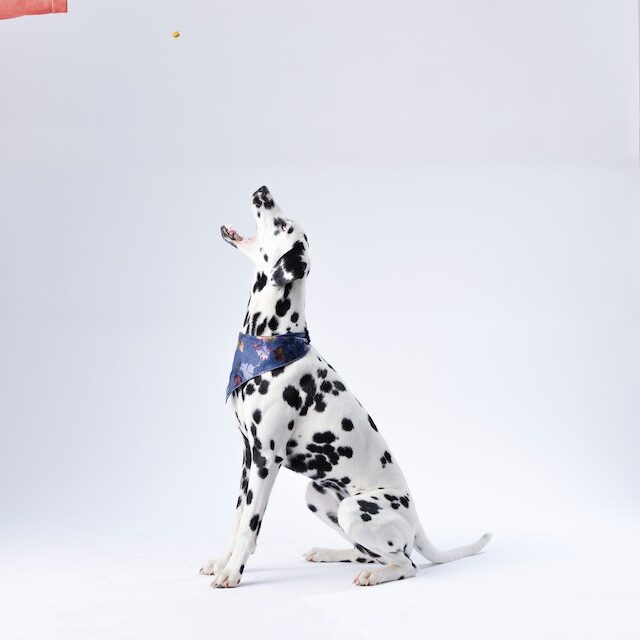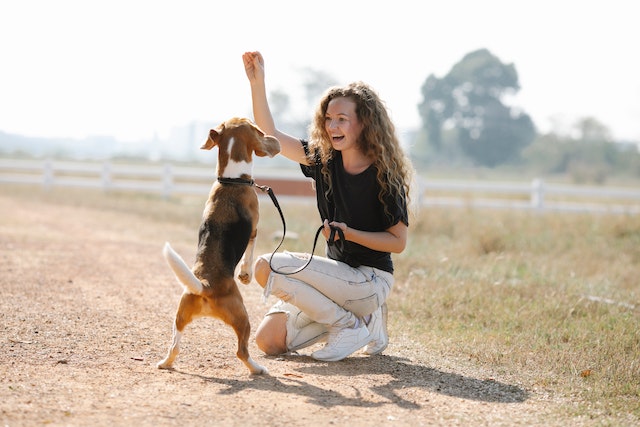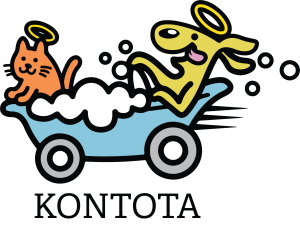Have you just adopted a new puppy and don’t know where to start? No worries; we’ve got your back. Training is a highly controversial topic among pet owners. Some methods may seem inhumane, while others might sound simply illogical. In this article, we’ll go over the different methods you can use to train a new puppy and what you should teach them first.
Different Training Methods Explained

There are multiple different approaches that pet owners take to train a new puppy. It’s important to know that training is never the same for every dog. It’s a good idea to attempt different methods with your pup and find which ones work best. If you’re unsure of which methods to use, or if you’re tackling a behavior that isn’t listed in this article, it’s recommended to speak to a professional trainer.
Positive Reinforcement Training
Positive reinforcement training is the method we recommend to train a new puppy.
This method of training is a method of training where the trainer rewards the animal for exhibiting the desired behavior. It is based on the principle that animals are more likely to repeat a behavior that has been rewarded in the past. Positive reinforcement training is a humane and effective way of training animals.
When using positive reinforcement training, the trainer rewards the animal with something it wants, such as a treat, toy, praise, or attention, immediately after the animal performs the desired behavior. This creates a positive association with the behavior and makes it more likely that the animal will repeat the behavior in the future.
Clicker Training
This method involves using a small hand-held clicker device to mark the desired behavior, followed by a reward. The click sound helps the puppy to understand exactly which behavior is being rewarded.
Operant Conditioning
This method involves using consequences to shape behavior. For example, using a verbal “no” or interrupting an undesired behavior and rewarding the desired behavior.
Classical Conditioning
This method is based on the principle that dogs learn by association. For example, if a dog learns that a certain behavior (like sitting) leads to a reward (like a treat), it will be more likely to repeat that behavior in the future.
Relationship-Based Training
This method emphasizes the importance of building a positive relationship between the trainer and the dog. It’s based on trust and mutual respect. This method will help to establish a good foundation for training and will help to make the training process more enjoyable for both the dog and the trainer.
Potty Training
Potty training a dog can take time and patience, but with the right approach, it can be done effectively. Here are some steps you can take to potty train your dog:
- Establish a routine: Dogs thrive on routine, so establish a schedule for feeding, drinking, and going outside to potty.
- Create a designated potty area: Take your dog to the same area in your yard every time it needs to go potty. This will help it to associate that area with going to the bathroom.
- Watch for signs that your dog needs to go potty: Some signs include sniffing around, circling, and whining. When you see these signs, take your dog outside to its designated potty area.
- Reward good behavior: When your dog goes potty in the designated area, reward it with treats, praise, or play.
- Supervise your dog: Keep an eye on your dog and confine it to a crate or small area when you can’t supervise it. This will prevent accidents in the house.
- Be patient: Potty training takes time and patience, so don’t get discouraged if accidents happen. Clean up messes with an enzymatic cleaner and remain consistent with your training.
- Consistency is key: Keep taking your dog out to the designated potty area at regular intervals and reward it when it goes potty there. This will help it to learn where it is appropriate to go to the bathroom.
It is important to remember that puppies have small bladders and need to go potty more frequently than adult dogs. they will need to be taken outside more often. Additionally, dogs are creatures of habit, so consistency in your training is key. With patience, consistency, and positive reinforcement, your dog will learn where it is appropriate to go to the bathroom.
Puppy Socialization
It is important to start socializing your puppy as early as possible, ideally between 3 to 14 weeks of age. This is the critical period for socialization. It is also important to remember that socialization is a lifelong process. Continue to expose your puppy to new experiences throughout its life.
Here are different methods you can use to socialize your puppy:
- Introduce your puppy to different people: Invite friends, family, and strangers over to meet your puppy. This will help it to become accustomed to different types of people and personalities.
- Take your puppy to different places: Take your puppy to different environments, such as parks, pet stores, and other public places. This will help it to become accustomed to different sights, sounds, and smells.
- Expose your puppy to different animals: Introduce your puppy to other dogs, cats, and other animals. This will help it to learn how to interact appropriately with other animals.
- Gradual exposure: Gradually expose your puppy to different experiences and environments. Avoid overwhelming it with too much new information at once.
- Use positive reinforcement: Reward your puppy with treats, praise, and play for calm and positive behavior when around new people, animals, and environments.
- Enroll in a puppy socialization class: Puppy socialization classes are a great way to socialize your puppy in a controlled and safe environment with other puppies and professional guidance.
Stopping Puppy Biting
It is important to note that biting is a natural behavior for puppies. Be patient and consistent when training them not to bite. With patience, consistency, and positive reinforcement, your puppy will learn that biting is not an appropriate behavior.
Here are some steps to take to stop your puppy from biting:
- Redirect the puppy’s attention: When the puppy starts to bite, try to redirect its attention to a toy or chew object that is appropriate for it to bite.
- Use positive reinforcement: Reward the puppy with treats or praise when it stops biting or when it plays appropriately.
- Teach the “Leave it” command: Train the puppy to “leave it” when it starts to bite. When the puppy stops biting, give it a treat or praise.
- Give a firm “no”: When the puppy bites, give a firm and loud “no” to indicate that the behavior is not acceptable.
- Avoid rough play: Avoid playing with your puppy in a way that encourages biting, such as tug-of-war or wrestling.
- Provide appropriate chew toys: Puppies need to chew for their teeth and jaw development. It’s important to provide appropriate chew toys for them to bite on.
Stopping Puppy Jumping
Many puppies have a problem with jumping too much. It is important to be consistent when training a puppy not to jump. It is also important to remember that jumping is a common behavior for puppies. Be patient with your puppy, and don’t punish them too severely. With patience, consistency, and positive reinforcement, your puppy will learn that jumping is not an appropriate behavior.
Here are some methods to stop your puppy from jumping:
- Ignore the behavior: When the puppy jumps, ignore it and don’t make eye contact or give it any attention. Once it stops jumping, give it praise or a treat.
- Teach the “sit” command: Train the puppy to “sit” when it starts to jump. Once it sits, give it a treat or praise.
- Use a leash: When you’re outside or in public, use a leash to keep the puppy under control.
- Give a firm “no”: When the puppy jumps, give a firm and loud “no” to indicate that the behavior is not acceptable.
- Avoid encouraging the behavior: Avoid encouraging the puppy to jump by petting it or giving it attention when it jumps.
- Provide appropriate outlets for energy: Puppies have a lot of energy, so it’s important to provide them with plenty of opportunities to burn it off through exercise and play.
Leash Train a New Puppy
Leash training a puppy can be a bit of a challenge, but with patience and consistency, it can be done. Here are some steps you can follow to leash train your puppy:
- Start indoors: Begin the training process indoors where there are no distractions. Attach the leash to your puppy’s collar and let them walk around the room with you. This will help them get used to the feel of the leash and collar.
- Gradually move outside: Once your puppy is comfortable walking with the leash inside, gradually move the training outside. Start in a quiet, enclosed area and gradually move to busier areas as your puppy becomes more comfortable.
- Use positive reinforcement: Use treats and praise to reward your puppy for good behavior on the leash. This will help them associate the leash with positive experiences.
- Keep the leash loose: Avoid pulling or yanking on the leash. Instead, keep the leash loose and give your puppy some slack to explore their surroundings.
- Practice, practice, practice: Consistency is key when leash training a puppy. Set aside time each day to practice walking with your puppy. Don’t get discouraged if it takes a little longer for them to learn.
- Never use physical force or punishment to train your puppy, it will make them more scared and aggressive.
- Always use a comfortable and well-fitting collar and leash for your puppy.
- And lastly, be patient. It will take time for your puppy to learn, but with patience, consistency, and positive reinforcement, your puppy will be leash trained in no time.
First Tricks to Teach

Teaching your new puppy tricks can be a fun and enjoyable bonding experience for both you and your puppy. Here are some tricks that you can teach your new puppy:
- Sit: This is one of the most basic and essential tricks to teach your puppy. It’s a good starting point for other commands and tricks.
- Stay: Once your puppy knows how to sit, you can teach them to stay in that position until you release them with a command.
- Come: Teaching your puppy to come when called is important for their safety and can be a lifesaver in emergency situations.
- Lie down: Teaching your puppy to lie down on command can be a good follow-up trick to “sit” and “stay.”
- Roll over: This trick can be fun to teach and is a great way to get your puppy to engage in physical activity.
- Shake Hands: This trick is a cute way to show off your puppy’s smarts and can be a great conversation starter.
- High Five: Similar to shake hands, it’s a fun trick that puppies can learn with a little practice.
- Speak or bark on command: Teaching your puppy to speak or bark on command can be a fun trick. It’s also a great way to help them learn how to use their voice appropriately.
- Play Dead: it’s a fun trick and it’s also a good way to practice the “lie down” command.
- Fetch: this trick is a great way to bond with your pup and to help them expend some energy.
Remember, each puppy is different and they learn at different pace. It’s important to be patient and use positive reinforcement techniques to encourage them to learn. Check out Zak George’s YouTube for tips and tricks on how to train a new puppy from scratch.
Thank you for reading
We will be posting in-depth blog posts related to dog grooming, dog breeds, dog training tips, and much more. Don’t forget to tag us on Instagram or follow our FaceBook page! Read our other article about tricks to teach your dog here.
